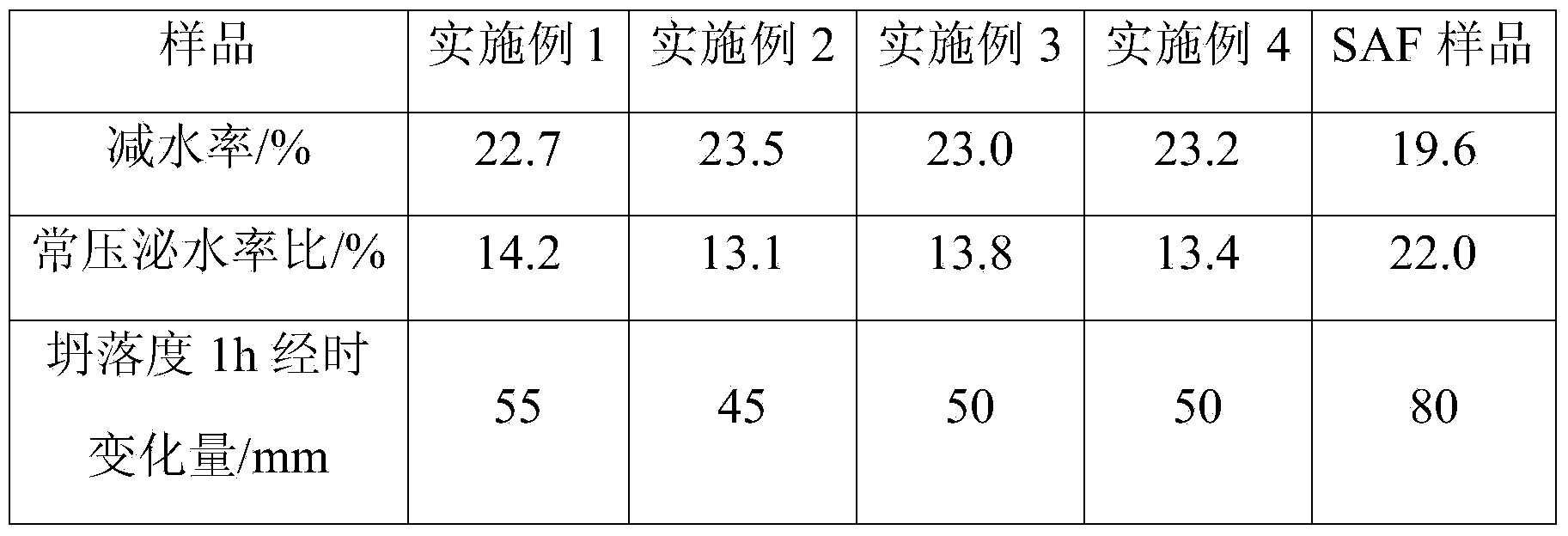Method for preparing modified aliphatic series water reducing agent
An aliphatic water reducer and modification technology, which is applied in the field of chemical building materials, can solve the problems of industrial application limitations, high production costs, and rapid loss of aliphatic water reducers over time, so as to improve slump retention performance and production costs Decline, the effect of good industrial application prospects
- Summary
- Abstract
- Description
- Claims
- Application Information
AI Technical Summary
Problems solved by technology
Method used
Image
Examples
Embodiment 1
[0023] (1) In parts by mass, add 30 parts of sodium bisulfite, 130 parts of formaldehyde and 70 parts of water to the first reaction kettle, stir and dissolve for 0.5 hours, and when the temperature is controlled below 30°C, add 40 parts of waste acetone at one time and 15 parts of pure acetone, after continuing to react for 0.5 hours, add 1 part of polyethylene glycol and 2 parts of propylene glycol to obtain the first mixed solution; in the above-mentioned waste acetone, the content of acetone is 85-95%, and the rest are impurities, and the impurities including pyruvic acid, unsaturated resins, oils and rosin resins;
[0024] (2) In parts by mass, in the second reaction kettle, add 30 parts of sodium sulfite and 100 parts of water, stir to dissolve, add liquid caustic soda to adjust the pH to 12, and control the reaction temperature to 40-50°C, and pour the Add the above-mentioned first mixed solution dropwise within 2 hours, and control the temperature not to exceed 90°C; ...
Embodiment 2
[0027] (1) In parts by mass, add 25 parts of sodium bisulfite, 120 parts of formaldehyde and 70 parts of water into the first reaction kettle, stir and dissolve for 0.5 hours, and when the temperature is controlled below 30°C, add 30 parts of waste acetone at one time and 20 parts of pure acetone, after continuing to react for 0.5 hours, add 2 parts of dimethylacetamide and 1 part of ethylenediamine to obtain the first mixed solution; in the above-mentioned waste acetone, the content of acetone is 85% to 95%, and the rest is Impurities, and impurities include pyruvic acid, unsaturated resins, oils and rosin resins;
[0028] (2) In parts by mass, in the second reaction kettle, add 40 parts of sodium pyrosulfate and 100 parts of water, stir to dissolve, add liquid alkali to adjust the pH to 12, and control the reaction temperature to 40-50°C, add Add the above-mentioned first mixed solution dropwise within 2 hours at a constant speed, and control the temperature not to exceed 90...
Embodiment 3
[0031] (1) In parts by mass, add 40 parts of sodium bisulfite, 140 parts of formaldehyde and 70 parts of water to the first reaction kettle, stir and dissolve for 0.5 hours, and when the temperature is controlled below 30°C, add 60 parts of waste acetone at one time After continuing to react for 0.5 hours, add 3 parts of polyethylene glycol to obtain the first mixed solution; in the above-mentioned waste acetone, the content of acetone is 85-95%, and the rest are impurities, and the impurities include pyruvic acid, unsaturated resin, Fats and rosin resins;
[0032] (2) In parts by mass, in the second reaction kettle, add 20 parts of sodium pyrosulfate, 15 parts of sodium sulfite and 100 parts of water, stir to dissolve, add liquid alkali to adjust the pH to 12, and control the reaction temperature to 40-50 °C, add the above-mentioned first mixed solution dropwise within 2 hours at a constant speed, and control the temperature not to exceed 90 °C;
[0033] (3) After the first ...
PUM
 Login to View More
Login to View More Abstract
Description
Claims
Application Information
 Login to View More
Login to View More - R&D
- Intellectual Property
- Life Sciences
- Materials
- Tech Scout
- Unparalleled Data Quality
- Higher Quality Content
- 60% Fewer Hallucinations
Browse by: Latest US Patents, China's latest patents, Technical Efficacy Thesaurus, Application Domain, Technology Topic, Popular Technical Reports.
© 2025 PatSnap. All rights reserved.Legal|Privacy policy|Modern Slavery Act Transparency Statement|Sitemap|About US| Contact US: help@patsnap.com


